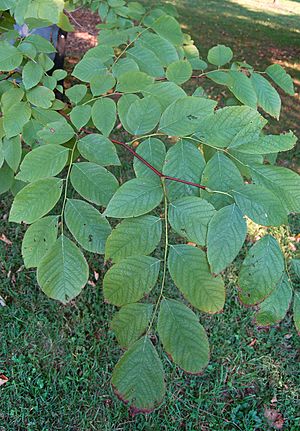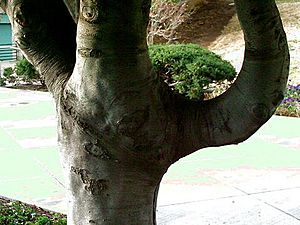Kentucky yellowwood facts for kids
Quick facts for kids Kentucky yellowwood |
|
|---|---|
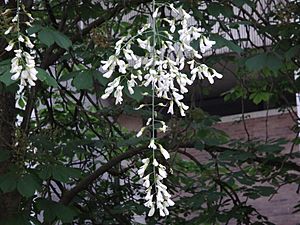 |
|
| Kentucky yellowwood flowers | |
| Scientific classification | |
| Genus: |
Cladrastis
|
| Species: |
kentukea
|
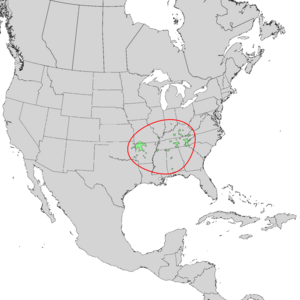 |
|
| Natural range of Cladrastis kentukea | |
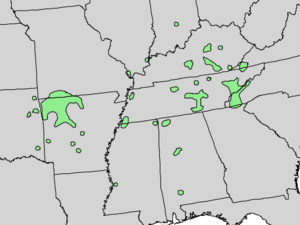 |
|
| Close-up of natural range of Cladrastis kentukea | |
| Synonyms | |
|
|
The Kentucky yellowwood (also known as the American yellowwood) is a beautiful tree. Its scientific name is Cladrastis kentukea. This tree is native to the southeastern parts of the United States.
You can find it in places like western North Carolina and eastern Oklahoma. It also grows from southern Missouri and Indiana down to central Alabama. Sometimes, people call this tree Virgilia.
Contents
About the Yellowwood Tree
The Kentucky yellowwood is a small to medium-sized tree. It loses its leaves in the fall, so it's called a deciduous tree. It usually grows about 10 to 15 meters (33 to 49 feet) tall. Some can even reach 27 meters (89 feet)!
This tree has a wide, rounded top, like a big umbrella. Its bark is smooth and gray. The leaves are made up of smaller leaflets. They are about 20–30 cm (8–12 inches) long. Each leaf has 5 to 11 leaflets, usually 7 to 9. These leaflets are broad and oval-shaped. They are 6–13 cm (2–5 inches) long. The underside of the leaves can be a bit hairy. In the fall, the leaves turn bright yellow, gold, and orange.
Flowers and Fruit
The yellowwood tree has lovely, sweet-smelling white flowers. They grow in long clusters, much like the Wisteria plant. These clusters can be 15–30 cm (6–12 inches) long. The tree blooms in early summer, usually in June. It doesn't flower heavily every year. Instead, it has a lot of flowers every two or three years.
After the flowers, the tree produces fruit. The fruit is a pod, which looks like a bean pod. These pods are 5–8 cm (2–3 inches) long. Each pod holds 2 to 6 seeds.
Wood and Bark
The wood of the Kentucky yellowwood is special. It is yellow to light brown in color. It is also heavy, hard, and strong. This is why the tree gets its name, "yellowwood." The bark is smooth and gray. Sometimes it can be light brown. Young branches are yellowish-green and smooth. As they get older, they turn reddish-brown and then dark brown.
Where Yellowwoods Grow
The Kentucky yellowwood is quite rare in eastern North America. It mostly grows on limestone cliffs. You can find it in Kentucky, Tennessee, and North Carolina. However, it can grow in colder areas too.
The biggest known yellowwood tree is in Spring Grove Cemetery in Cincinnati, Ohio. It is 22 meters (72 feet) tall. Its trunk is 2.2 meters (7 feet) wide. The tallest known tree is in Georgia. It is 27 meters (89 feet) tall. But its trunk is much thinner, only 0.55 meters (1.8 feet) wide.
Some yellowwood trees from Alabama have hairier leaves. These are a special type called Cladrastis kentukea f. tomentosa.
Growing Yellowwood Trees
People often plant the Kentucky yellowwood as an ornamental tree. This means it's grown for its beauty. Its attractive flowers make it popular in gardens. It has even started growing naturally in some areas outside its original home.
This tree likes a lot of sunlight. It also needs soil that drains water well. It can grow in different types of soil, both high and low in pH. The yellowwood tree can handle city environments. Birds also like this tree.
There are different types of yellowwood trees that people have grown. One popular type is 'Perkin's Pink'. This one has pink flowers instead of white. Many experts say the Kentucky yellowwood is one of the best medium-sized trees for gardens. One thing to know is that its trunk might split into several parts close to the ground. This makes it look like it has many trunks.
Uses of Yellowwood
The name "yellowwood" comes from the yellow color of its inner wood. This special wood is used for small amounts of fine furniture. It is also used for parts of gunstocks and for decorative woodturning.
Awards and Recognition
The Kentucky yellowwood has received special awards.
- In 1994, it won a Gold Award from the Pennsylvania Horticultural Society.
- The Society of Municipal Arborists chose the yellowwood as its Urban Tree of the Year in 2015.
See also
 In Spanish: Cladrastis kentukea para niños
In Spanish: Cladrastis kentukea para niños


